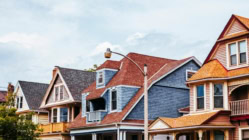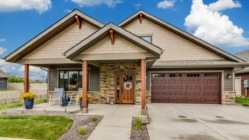Can You Really Afford a $250,000 Home?
When it comes to buying a home, one of the first questions to arise is, “How much can I afford?” And if you’ve set your eyes on a $250,000 home, understanding your financial capability is crucial. Buying a home is a significant financial commitment and various factors can influence your affordability.
The Key Factors to Consider When Buying a $250,000 Home
The decision to purchase a $250,000 home entails more than just covering the purchase price.
Firstly, think about the extra factors that influence your housing payment. Property taxes, homeowners’ insurance, and interest rates, for example, can greatly impact your financial planning and the house you can afford.
Secondly, evaluate the size of your down payment. A higher amount, such as a 20% down payment, will obviously reduce your mortgage loan, and thus lower your monthly payments. This also has the potential to secure you a more favorable interest rate. However, there are plenty of low-down-payment options available that will not impact your interest if you’re a first-time homebuyer.
Thirdly, the type of financing you opt for will influence your affordability. The type of loan (Conventional Loan, FHA Loan, VA Loan, etc.) as well as the kind of mortgage rate you choose (fixed-rate or adjustable-rate mortgage) you choose will make a difference in your monthly payments.
Lastly, your existing financial obligations play a significant role. Assessing your debt ratios can give you a clear picture of how large of a mortgage loan you can manage. Understanding all of these aspects will aid in making a sound financial decision when buying a $250,000 home.
How Your Down Payment Size Impacts Affordability
Your down payment, as I am sure you know, is the amount of money you need to “put down” or bring in at the close of escrow in conjunction with your mortgage financing to enable you to cover the full cost of your home. Down payments can impact affordability in two ways.
Firstly, as mentioned above, a larger payment necessarily results in a smaller mortgage loan – which, of course, also means lower mortgage payments. And secondly, a larger down payment can also result in a lower interest rate. This is because lenders consider loans associated with larger down payments to be lower risk, and they therefore offer lower interest rates to borrowers making larger down payments.
But, please do not be discouraged if you do not have sufficient funds for a large down payment. FHA and VA loan interest rates are not impacted by down payment size at all. Conforming or conventional loans backed by Fannie Mae and Freddie Mac no longer penalize first-time homebuyers with higher rates if they make a small down payment, in most cases.
In any case, assessing how much down payment you can afford remains a crucial step in your homebuying journey.
Debt Ratios and Loan Limits: Why They Matter
Your ability to afford a $250,000 home greatly hinges on two important parameters – debt ratios and loan limits. Lenders evaluate your financial stability through debt ratios, which encompass two key metrics.
- The Front-End Ratio calculates your monthly housing payment (principal, interest, property taxes, insurance and HOA dues) as a percentage of your gross monthly income.
- The Back-End Ratio accounts for your total monthly debt payments, including your housing payment, as a percentage of your income.
Both of these ratios should ideally not be too high, and they have specific limits depending on the type of loan you obtain and how good your credit is, among other things.
The ratios account for all of your monthly debt payments, including your mortgage, property taxes, homeowner’s insurance, and any other consumer debts such as car loans, student loans, and credit card payments. Fannie Mae’s and Freddie Mac’s guidelines allow for debt ratios up to almost 50%, meaning up to half of your gross income can go towards servicing debt.
In addition to debt ratios, loan limits also play an instrumental role in your home purchasing process. These are the maximum loan amounts that lenders, or in some cases, government bodies, allow in specific areas (usually counties). The size and cost of the house you desire could potentially exceed these limits, leading to the need for a higher down payment or other financial adjustments. It is rare, however, for a loan amount up to $250,000 to ever exceed a loan limit in any area.
Loan Example for a $250,000 Home:
- Annual Household Salary: $60,000*
- Purchase Price: $250,000
- Loan Amount: $225,000 (after a 10% down payment of $25,000)
- Monthly Property Taxes: $312.50* (assuming $3,750 per year or a rate of 1.5%)
- Homeowners Insurance: $67* (or $800 per year)
- Private Mortgage Insurance (PMI): $56.25* (assuming $675 per year, required for down payments less than 20%)
- Monthly Mortgage Payment: $1,497* (at a 7% interest rate), $1,349* (at 6%), or $1,209* (at 5%)
If a borrower has no other debt obligations, a conforming loan for a $250,000 property with 10% down in a 7% rate environment would require a gross monthly income of approximately $3,870, factoring in a 50% debt ratio. This translates to an annual salary of around $46,450. In a 6% rate environment, that same borrower would only need to earn $3,570 per month or a bit less than $43,000 per year. If the rate is only 5%, that borrower would need a salary of less than $40,000 per year.
So, as you can see, a $250,000 home is well within reach for individuals or families earning an annual salary of $60,000, even in a higher interest rate environment. Remember to factor in any extra consumer debt payments, as they would raise the income needed to meet the acceptable debt ratio. A $500 car payment for example, in the 7% scenario above, would raise the annual income requirement to over $58,000.
Use the home affordability calculator provided below to determine what purchasing scenarios fit within your financial landscape.
*Note: These figures are simplified estimates. Actual rates and payments may vary. Both homeowners’ insurance and property tax rates can vary tremendously, depending on the area. Always consult with a mortgage advisor to understand your specific situation and options.
The Role of Financing and Interest Rates
Your choice of mortgage type and the current interest rate environment are paramount when contemplating the affordability of a $250,000 home. There are primarily two types of mortgage financing options to choose from – fixed-rate mortgages and adjustable-rate mortgages.
- A fixed-rate mortgage offers predictable monthly payments, given that the interest rate remains the same throughout the loan term. This allows for easier budgeting and financial planning.
- An adjustable-rate mortgage comes with variable interest rates, which could initially provide lower payments. However, it’s crucial to remember that these rates can increase over time, leading to higher future payments.
While adjustable-rate mortgages sometimes offer lower rates, and lower rates obviously translate to lower payments, it is important to remember that adjustable rates are sometimes not significantly lower than fixed rates. This is because we sometimes live in a financial environment known as an inverted yield curve, where short-term rates are higher than long-term rates.
This is unusual because long-term rates are normally higher because longer-term loans entail more risk. This environment has been prevalent since the end of the COVID-related rate reductions, so very few borrowers have been opting for variable-rate loans.
In any case, understanding the relationship between interest rates and home affordability is key in making an informed decision on whether a $250,000 home is within your financial reach.
View mortgage rates for
April 26, 2024
Do Interest Rates Affect Affordability?
Changes in interest rates obviously impact affordability, as higher rates mean higher mortgage payments and lower rates mean lower mortgage payments. You should therefore monitor the rate environment carefully after you have been pre-approved for mortgage financing or when you are shopping for a home in general. A good mortgage lender will of course keep you apprised of what is happening with interest rates. At JVM Lending, for example, we send out constant mortgage rate updates to all of our pre-approved buyers.
But, the important thing to remember is that rates impact your ability to afford a $250,000 home. The example we set above perfectly illustrates how much too, as each 1% increase in rate required at least $3,000 more in annual income.
What About Qualifying in Very Low Interest Rate Environments?
In a low-interest-rate environment, borrowing becomes more affordable for home buyers. However, this does not necessarily mean qualifying for a mortgage becomes easier. Some lenders may tighten their credit standards to mitigate risk, especially if they anticipate an economic downturn. Consequently, you might face stricter requirements regarding credit scores, employment history, or debt-to-income ratios.
While lower interest rates can reduce your monthly mortgage payments, they may also inflate home prices due to increased demand. This is something we saw during the COVID crisis, and if prices climb high enough not only will it offset savings from lower rates, but it will require you to bring in a larger down payment as well – if you want to maintain the same down payment percentage.
As an alternative to bringing in a larger payment in dollar terms, however, you could make a smaller down payment in percentage terms. For example, if you have $25,000 saved for a 10% down payment for a $250,000 home purchase, but the price of that home increases to $300,000 in a low-rate environment, your down payment percentage will drop to 8.33%. This will impact your loan-to-value ratio, a critical factor that lenders consider when assessing your qualifications, interest rate and mortgage insurance requirement.
It’s crucial to understand these nuances to navigate the homebuying process effectively in a low-interest-rate environment. Remember, while low interest rates can present opportunities, understanding their broader implications is key to making a well-informed homebuying decision.
Property Taxes, Homeowners’ Insurance, and Your Budget
Don’t underestimate the impact of property taxes and homeowners’ insurance on your budget when considering the affordability of a $250,000 home. These aren’t one-time payments like a down payment, but ongoing costs you’ll need to manage along with your mortgage.
- Property taxes can vary greatly depending on your location and the value of your home. You may need to budget for annual or semi-annual payments that could amount to thousands of dollars each year.
- Homeowners’ insurance is another cost to consider. Your premium will depend on factors like the value of your home, the area you live in, and the amount of your deductible. You can pay this annually or, in some cases, it can be included in your monthly mortgage payment.
Ignoring these expenses could result in budget strain and potential financial stress. It’s crucial to calculate these additional costs and incorporate them into your monthly housing budget to get a realistic picture of what owning a $250,000 home truly costs.
Always remember that the real cost of homeownership extends beyond the mortgage payment. Accurate budgeting and financial planning are essential to ensure you can comfortably afford your new home.
How Do Loan Limits Affect Your Home Purchase?
Loan limits refer to the maximum amount that can be borrowed for a conforming loan, as set by government-sponsored entities like Fannie Mae and Freddie Mac. These limits vary by state and county and are adjusted annually based on local real estate market conditions. But, as mentioned above, when you’re setting your sights on a $250,000 home, there are very regions will loan limits will be a factor to worry about.
Keep in mind, loan limits increase if you decide to buy units instead of a single-family home. Loan limits get larger if you buy a duplex, triplex, or fourplex, respectively. So, even though it is unlikely that the loan limits will impact you, it is still wise to check the loan limits in your area before you start shopping for a home.
Loan limits are just another layer to consider in your journey to owning a $250,000 home, but they are a rarely a roadblock. We have mortgage experts available to help answer any questions you might have about the loan limits in the area where you are thinking of purchasing a home.
Frequently Asked Questions
What annual salary is required to comfortably afford such a property?”
It depends on things like your debts, your down payment amount, and the interest rate on your home loan. The salary requirement could range anywhere from $40,000, up to $75,000, or more.
How does the down payment size impact my monthly mortgage payments?”
A larger down payment reduces the loan amount and therefore your payments, as mortgage payments are always dependent on loan amounts. A larger down payment can potentially reduce your interest too, further reducing your payment.
How does the current interest rate environment impact home affordability?”
Mortgage interest rates directly influence your borrowing costs. A lower rate decreases your monthly payments, making a home more affordable, while a higher rate does the opposite. But, keep in mind too that very low rates often have the impact of driving up home prices.
Next Steps
The process of buying a home isn’t just about finding a property you love, but also ensuring that you can comfortably afford it.
To afford a $250,000 house, the salary requirements vary based on these factors:
- Down payment size
- Property tax rates
- Homeowners’ insurance
- Type of financing
- Private mortgage insurance
- Conforming loan limits
- The overall interest rate environment
- Monthly consumer debt payments
The required salary can vary depending on a variety of factors, as set out above. In low-rate environments with large down payments, it can be under $35,000 per year.
If you’re buying in a high-rate environment though, with a small down payment and higher property tax and insurance costs along with relatively large consumer debt payments, the required salary can easily climb to over $75,000 per year. By talking with one of JVM Lending’s experienced Client Advisors, you can easily find out what sort of home fits your budget.
Get in touch with our team at JVM Lending today to see what you can truly afford. Let’s make your dream home more than just a dream—let’s make it your reality.
Ready to take the next step? Contact JVM Lending now at (855) 855-4491 or [email protected] to embark on this exciting journey together!
*Remember, these are just assumptions. Your actual needs may vary based on your credit score, the area in which you are buying, the state of the real estate market, interest rates, and other factors. Reach out to a mortgage expert at JVM Lending for a customized home purchase scenario and an outline of your potential costs.
























